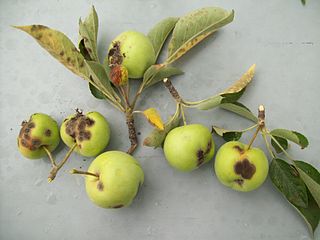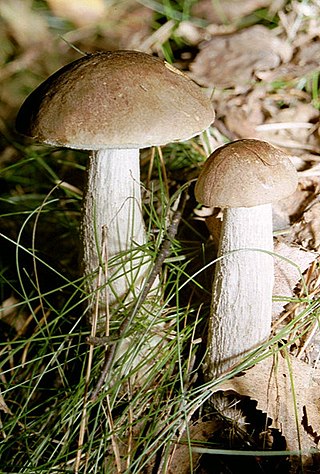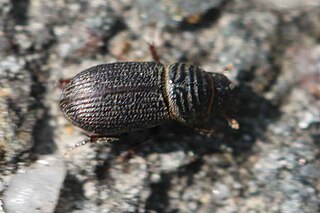
Guava is a common tropical fruit cultivated in many tropical and subtropical regions. The common guava Psidium guajava is a small tree in the myrtle family (Myrtaceae), native to Mexico, Central America, the Caribbean and northern South America. The name guava is also given to some other species in the genus Psidium such as strawberry guava and to the pineapple guava, Feijoa sellowiana. In 2019, 55 million tonnes of guavas were produced worldwide, led by India with 45% of the total. Botanically, guavas are berries.

Apple scab is a common disease of plants in the rose family (Rosaceae) that is caused by the ascomycete fungus Venturia inaequalis. While this disease affects several plant genera, including Sorbus, Cotoneaster, and Pyrus, it is most commonly associated with the infection of Malus trees, including species of flowering crabapple, as well as cultivated apple. The first symptoms of this disease are found in the foliage, blossoms, and developing fruits of affected trees, which develop dark, irregularly-shaped lesions upon infection. Although apple scab rarely kills its host, infection typically leads to fruit deformation and premature leaf and fruit drop, which enhance the susceptibility of the host plant to abiotic stress and secondary infection. The reduction of fruit quality and yield may result in crop losses of up to 70%, posing a significant threat to the profitability of apple producers. To reduce scab-related yield losses, growers often combine preventive practices, including sanitation and resistance breeding, with reactive measures, such as targeted fungicide or biocontrol treatments, to prevent the incidence and spread of apple scab in their crops.

Porcellio scaber, is a species of woodlouse native to Europe but with a cosmopolitan distribution. They are often found in large numbers in most regions, with many species preying on them.

Leccinum scabrum, commonly known as the rough-stemmed bolete, scaber stalk, and birch bolete, is an edible mushroom in the family Boletaceae, and was formerly classified as Boletus scaber. The birch bolete is widespread in Europe, in the Himalayas in Asia, and elsewhere in the Northern Hemisphere, occurring only in mycorrhizal association with birch trees. It fruits from June to October. This mushroom is also becoming increasingly common in Australia and New Zealand where it is likely introduced.

Venturia inaequalis is an ascomycete fungus that causes the apple scab disease.

Malus floribunda, common name Japanese flowering crabapple, Japanese crab, purple chokeberry, or showy crabapple, originates from Japan and East Asia. It may be a hybrid of M. toringo with M. baccata, in which case it would be written as Malus × floribunda.

Vermicularia is a genus of sea snails, marine gastropod mollusks in the family Turritellidae.
The Black Andrew Nature Reserve is a protected nature reserve located on the south west slopes of New South Wales, Australia. The 1,559-hectare (3,850-acre) reserve is situated on the southern shore of Burrinjuck Dam on the Murrumbidgee River, an important reservoir for the Murrumbidgee Irrigation Area.

Scarus scaber, the five-saddle parrotfish or dusky-capped parrotfish, is a species of marine ray-finned fish, a parrotfish, in the family Scaridae. It is native to Indian Ocean.
The PRI disease resistant apple breeding program is a joint project of the Purdue University, Rutgers University, and the University of Illinois, to breed apple cultivars to be resistant to apple scab. The initialism stands for the three involved universities: Purdue, Rutgers and Illinois.

Eccremocarpus scaber, the Chilean glory-flower or Chilean glory creeper, is a species of perennial plant in the Bignoniaceae family. It is found in Chile.
Ectemnius scaber is a species of square-headed wasp in the family Crabronidae. It is found in North America.

Hylastes is a genus of crenulate bark beetles in the family Curculionidae. There are more than 90 described species in Hylastes.

Romualdius scaber, known generally as the crusted root weevil or crusted grass weevil, is a species of broad-nosed weevil in the beetle family Curculionidae. It is found in Europe and North America.

Rhyssemus germanus is a species of aphodiine dung beetle in the family Scarabaeidae. It is found in Europe and Northern Asia and North America.
Phyllobaenus scaber is a species of checkered beetle in the family Cleridae. It is found in North America.

Sphaerodactylus richardi, also known commonly as Richard's banded sphaero or the Zapata big-scaled sphaero, is a small species of gecko, a lizard in the family Sphaerodactylidae. The species is endemic to Cuba.

Sphaerodactylus scaber, also known as the double-collared sphaero or Camaguey least gecko, is a small species of gecko endemic to Cuba.

Rhyssemus inscitus, is a species of dung beetle widespread throughout Afro-Oriental regions, Indochinese regions and Australia.

Porcellio scaber lusitanus is a subspecies of Porcellio scaber endemic to Spain and Portugal. Described in 1907 as Porcellio lusitanus the species was later lowered to a subspecies level despite being referred to as a form. It is highly likely that Porcellio scaber lusitanus are normal P. scaber with Allometric Growth.















